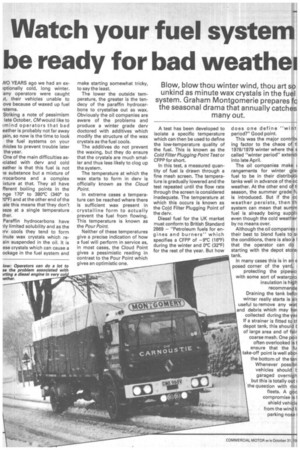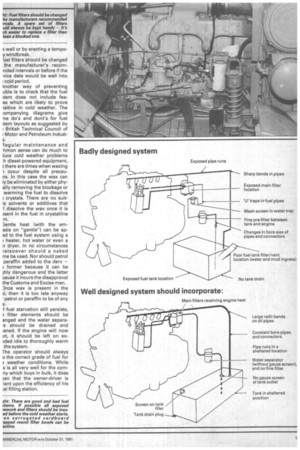Watch your fuel syste be ready for bad weathth
Page 40

Page 41

If you've noticed an error in this article please click here to report it so we can fix it.
Blow, blow thou winter wind, thou art so unkind as minute wax crystals in the fuel system. Graham Montgomerie prepares ft the seasonal drama that annually catches many out.
NO YEARS ago we had an exiptionally cold, long winter. any operators were caught it, their vehicles unable to ove because of waxed up fuel 'stems.
Striking a note of pessimism late October, CM would like to :mind operators that bad eather is probably not far away jain, so now is the time to look the fuel systems on your :hides to prevent trouble later the year.
One of the main difficulties assciated with dery and cold eather is that this fuel is not le substance but a mixture of frocarbons and a complex ixture at that. They all have fferent boiling points in the nge 1700 to 380°C (340° to !0°F) and at the other end of the :ale this means that theydon't ?eze at a single temperature ther.
Paraffin hydrocarbons have tly limited solubility and as the :rv cools they tend to form iflute wax crystals which ream n suspended in the oil. It is ese crystals which can cause a ockage in the fuel system and make starting somewhat tricky, to say the least.
The lower the outside temperature, the greater is the tendecy of the paraffin hydrocarbons to crystalise out as wax. Obviously the oil companies are aware of the problems and produce a winter grade dery doctored with additives which modify the structure of the wax crystals as the fuel cools.
The additives do not prevent the waxing, but they do ensure that the crystals are much smaller and thus less likely to clog up the system.
The temperature at which the wax starts to form in dery is officially known as the Cloud Point.
In extreme cases a temperature can be reached where there is sufficient wax present in crystalline form to actually prevent the fuel from flowing. This temperature is known as the Pour Point.
Neither of these temperatures give a precise indication of how a fuel will perform in service as, in most cases, the Cloud Point gives a pessimistic reading in contrast to the Pour Point which gives an optimistic one. A test has been developed to isolate a specific temperature which can then be used to define the low-temperature quality of the fuel. This is known as the Cold Filter Plugging Point Test or CFPP for short.
In this test, a measured quantity of fuel is drawn through a fine mesh screen. The temperature is gradually lowered and the test repeated until the flow rate through the screen is considered inadequate. The temperature at which this occurs is known as the Cold Filter Plugging Point of the derv.
Diesel fuel for the UK market must conform to British Standard 2869 — "Petroleum fuels for engines and burners" which specifies a CFPP of —9°C (16°F) during the winter and 0°C (32°F) for the rest of the year. But how
does one define "wint, period?" Good point.
This was the major contribt ing factor to the chaos of ti 1978/1979 winter where the s called "winter period" extends into late April.
The oil companies make rangements for winter gras fuel to be in their distributis tanks well in advance of the co weather. At the other end of ti season, the summer grade ft, is introduced. But if the co weather persists, then th system can mean that summ fuel is already being supplis even though the cold weather by no means over.
Although the oil companies s their best to blend fuels to st the conditions, there is also a I that the operator can do starting with the depot storas tank.
In many cases this is in an e posed corner of the yard, : protecting the pipewo with some sort of waterpro, insulation is high recommende Draining the tank beim winter really starts is al.1 useful to remove any wat and debris which may haN collected during the yea If a strainer is fitted to depot tank, this should t of large area and of fair coarse mesh. One pair often overlooked is t ensure that the fu take-off point is well aboN the bottom of the tan Whenever possibl, vehicles should t garaged overnigh but this is totally out s the question with ma fleets. A goo compromise is I shield vehicle from the wind parking nose i 3 wall or by erecting a tempoy windbreak.
'uel filters should be changed the manufacturer's recomnded intervals or before if the vice date would be well into cold period.
knother way of preventing uble is to check that the fuel ;tem does not include feaes which are likely to prove Isitive in cold weather. The :ompanying diagrams give Tie do's and dont's for fuel item layouts as suggested by British Technical Council of Motor and Petroleum Industs.
Regular maintenance and rmon sense can do much to luce cold weather problems :h diesel-powered equipment, t there are times when waxing occur despite all precauns. In this case the wax can ly be eliminated by either phyally removing the blockage or warming the fuel to dissolve crystals. There are no suit e solvents or additives that I dissolve the wax once it is )sent in the fuel in crystalline flu.
3entle heat (with the emasis on "gentle" can be aped to the fuel system using a ; heater, hot water or even a ir dryer. In no circumstances latsoever should a naked me be used. Nor should petrol paraffin added to the dery — ) former because it can be Oily dangerous and the latter cause it incurs the disapproval the Customs and Excise men. )ice wax is present in the )l, then it is too late anyway • petrol or paraffin to be of any a.
f fuel starvation still persists, ) filter elements should be anged and the water separa:s should be drained and !aned. If the engine will now irt, it should be left on exIded idle to thoroughly warm the system.
rhe operator should always e the correct grade of fuel for ) weather conditions. While s is all very well for the cornfly which buys in bulk, it does an that the owner-driver is iant upon the efficiency of his :al filling station.










































